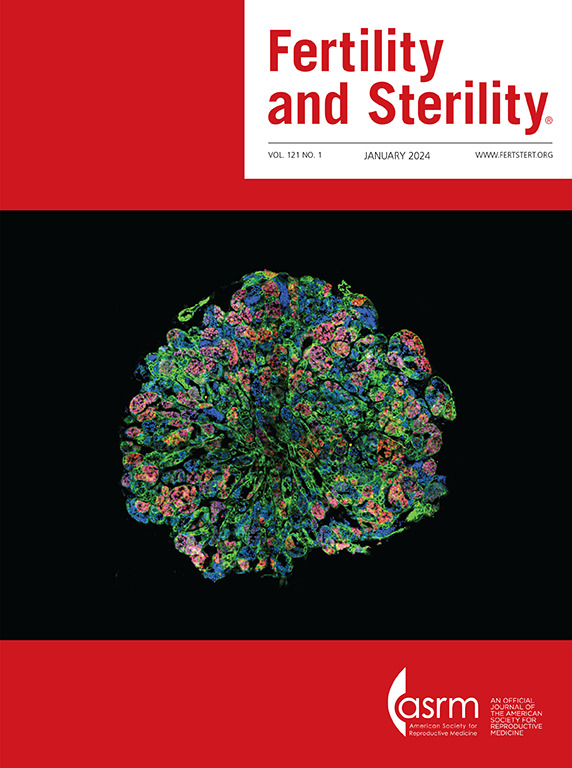Linzagolix with and without hormonal add-back therapy for symptomatic uterine fibroids: PRIMROSE 1 & 2 long-term extension and withdrawal study.
IF 6.6
1区 医学
Q1 OBSTETRICS & GYNECOLOGY
引用次数: 0
Abstract
OBJECTIVES To evaluate 1) whether oral linzagolix administered once daily for up to 52 weeks (extension study) at a dose of 100 mg or 200 mg with or without hormonal add-back therapy (ABT) (1.0 mg estradiol; 0.5 mg norethisterone acetate) can maintain the efficacy and tolerability seen at 6 months of therapy, and 2) whether there is any recurrence of symptoms (bleeding and pain) after cessation of therapy (withdrawal study). STUDY DESIGN PRIMROSE 1 and PRIMROSE 2 were essentially identical, randomized, parallel, double-blind, placebo-controlled phase 3 trials conducted in women with uterine fibroid-associated heavy menstrual bleeding (menstrual blood loss of more than 80 ml per cycle over 2 menstrual cycles). Eligible women with uterine fibroid-associated heavy menstrual bleeding were randomly assigned at a 1:1:1:1:1 ratio to one of five masked daily treatments: (1)placebo, (2)100 mg linzagolix alone, (3)100 mg linzagolix with hormonal ABT (1 mg estradiol and 0.5 mg norethisterone acetate), (4) 200 mg linzagolix alone (with ABT after 24 weeks), or (5) 200 mg linzagolix with hormonal ABT (1 mg estradiol and 0.5 mg norethisterone acetate). After 24 weeks, patients assigned to the placebo or 200 mg linzagolix alone groups were switched to 200 mg linzagolix with ABT, except in PRIMROSE 1, where 50% of subjects on a placebo continued with the placebo (random selection) until week 52. All other women continued on the original study medication. Efficacy and safety were evaluated at week 52 (extension study) as well as week 64 (withdrawal study). Bone mineral density was also assessed at week 76 (6 months after cessation of therapy). SETTING A total of 94 clinical sites in the USA (PRIMROSE 1) and 95 in Europe and the USA (PRIMROSE 2). PARTICIPANTS In PRIMROSE 1 and 2, 1,012 women were included in the full analysis set. Eligible subjects were women aged 18 years or older with ultrasound-confirmed fibroids and heavy menstrual bleeding of at least 80 ml blood loss per cycle for a minimum of two cycles, as determined by the alkaline haematin method. Eligible participants had to have at least one fibroid measuring 2 cm in diameter or more (or multiple small fibroids with overall uterine volume exceeding 200 cm3), but no fibroids greater than 12 cm in diameter. MAIN OUTCOMES MEASURES The primary endpoint was decreased menstrual blood loss to less than 80 ml and a reduction of more than 50% from baseline. Specifically, this study sought to determine whether the reduction in menstrual blood loss and other secondary outcomes, such as uterine volume and pain, observed at 24 weeks could be maintained over an extended (52 weeks) treatment period and further withdrawal period. MAIN RESULTS In the pooled data from PRIMROSE 1 and PRIMROSE 2 extension studies, the significantly higher proportion of women showing a reduction in heavy menstrual bleeding in all linzagolix (with or without ABT) treatment groups observed at week 24, was maintained until week 52. Percentages of women with reduced menstrual blood loss at week 52 (based on the pooled week 52 full analysis set) were 55.0% in the 100 mg group, 86.1% in the 100 mg with ABT group, 76.7% in the 200 mg group/200 mg with ABT, and 89.9% in the 200 mg with ABT group. Of subjects previously treated with linzagolix and in amenorrhoea by week 52, 88.8% reported their first bleed or heavy bleeding between weeks 52 and 64. In both PRIMROSE studies, the most common adverse events up to week 52 were hot flushes. Their incidence had returned to baseline values by week 64. Bone mineral density was well preserved in all groups at week 52. In women treated with 200 mg linzagolix alone up to week 24, initial BMD loss (lumbar spine) recovered by week 52 after adding ABT from week 24 onwards. CONCLUSIONS Findings at 52 weeks confirmed the benefits of treatment observed at 24 weeks. At 52 weeks, linzagolix (100 mg or 200 mg) with or without ABT was found to reduce heavy menstrual bleeding, which is a burden for women with uterine fibroids. Their quality of life was improved. Risks of bone loss and vasomotor symptoms were minimized as a result of ABT administration. Partial suppression with once daily linzagolix (100 mg) without ABT potentially provides a unique option for chronic treatment of symptomatic uterine fibroids in women who do not wish to have ABT or in whom it is contraindicated. The relatively fast recurrence of uterine fibroid-associated symptoms after cessation of therapy is an argument in favour of long-term continuation of treatment.林扎哥利克斯加和不加激素治疗症状性子宫肌瘤:PRIMROSE 1和2长期延长和停药研究。
目的:评估1)口服林扎哥利克斯是否每天一次,剂量为100mg或200mg,持续52周(扩展研究),伴或不伴激素补充治疗(ABT)(雌二醇1.0 mg;0.5 mg醋酸去甲睾酮)是否能维持治疗6个月时的疗效和耐受性,2)停药后是否有任何症状(出血和疼痛)复发(停药研究)。PRIMROSE 1和PRIMROSE 2基本上是相同的、随机的、平行的、双盲的、安慰剂对照的3期试验,在子宫肌瘤相关的重度月经出血(2个月经周期内每个月经周期失血超过80毫升)的女性中进行。符合条件的子宫肌瘤相关性月经大出血妇女按1:1:1:1:1的比例随机分配到5种每日治疗方案中的一种:(1)安慰剂,(2)单独使用100毫克林扎哥利加激素ABT(1毫克雌二醇和0.5毫克醋酸去甲睾酮),(3)100毫克林扎哥利加激素ABT(1毫克雌二醇和0.5毫克醋酸去甲睾酮),(4)单独使用200毫克林扎哥利加激素ABT(24周后使用ABT),或(5)200毫克林扎哥利加激素ABT(1毫克雌二醇和0.5毫克醋酸去甲睾酮)。24周后,被分配到安慰剂组或单独使用200毫克林扎哥利组的患者被切换到200毫克林扎哥利加ABT组,除了PRIMROSE 1组,其中50%的安慰剂组患者继续使用安慰剂(随机选择)直到第52周。所有其他女性继续服用最初的研究药物。在第52周(扩展研究)和第64周(戒断研究)评估疗效和安全性。在第76周(停止治疗后6个月)评估骨密度。在美国共有94个临床站点(PRIMROSE 1),在欧洲和美国共有95个临床站点(PRIMROSE 2)。在PRIMROSE 1和2,1,012名女性被纳入完整的分析集。符合条件的受试者是年龄在18岁或以上的女性,超声确诊为子宫肌瘤,经碱性血素法测定,月经大量出血,每周期至少失血量为80ml,且至少两个周期。符合条件的参与者必须至少有一个直径为2厘米或以上的肌瘤(或多个子宫总体积超过200厘米的小肌瘤),但没有直径大于12厘米的肌瘤。主要结局:主要终点是月经失血量减少到小于80毫升,比基线减少了50%以上。具体来说,本研究试图确定在24周观察到的月经出血量和其他次要结果(如子宫体积和疼痛)的减少是否可以在延长(52周)的治疗期和进一步的停药期保持。在PRIMROSE 1和PRIMROSE 2扩展研究的汇总数据中,在第24周观察到的所有林扎哥利(含或不含ABT)治疗组中,大量月经出血减少的女性比例显著增加,并持续到第52周。第52周月经出血量减少的女性百分比(基于第52周汇总的完整分析集):100 mg组为55.0%,100 mg合并ABT组为86.1%,200 mg /200 mg合并ABT组为76.7%,200 mg合并ABT组为89.9%。在先前接受linzagolix治疗并在第52周闭经的受试者中,88.8%的人在第52周至第64周报告了首次出血或大出血。在两项PRIMROSE研究中,直到第52周最常见的不良事件是潮热。他们的发病率在第64周恢复到基线值。第52周各组骨密度均保持良好。在仅使用200 mg林扎哥利克斯治疗至第24周的女性中,从第24周开始添加ABT后,初始BMD损失(腰椎)在第52周恢复。结论:52周时的结果证实了24周时观察到的治疗益处。在52周时,linzagolix (100mg或200mg)加ABT或不加ABT被发现可以减少月经大出血,这是子宫肌瘤妇女的负担。他们的生活质量得到了改善。由于ABT的使用,骨质流失和血管舒缩症状的风险被最小化。不含ABT的每日一次linzagolix (100mg)部分抑制可能为不希望接受ABT或有ABT禁忌的妇女提供一种独特的慢性治疗症状性子宫肌瘤的选择。停止治疗后子宫肌瘤相关症状的相对快速复发是支持长期继续治疗的一个论据。
本文章由计算机程序翻译,如有差异,请以英文原文为准。
求助全文
约1分钟内获得全文
求助全文
来源期刊

Fertility and sterility
医学-妇产科学
CiteScore
11.30
自引率
6.00%
发文量
1446
审稿时长
31 days
期刊介绍:
Fertility and Sterility® is an international journal for obstetricians, gynecologists, reproductive endocrinologists, urologists, basic scientists and others who treat and investigate problems of infertility and human reproductive disorders. The journal publishes juried original scientific articles in clinical and laboratory research relevant to reproductive endocrinology, urology, andrology, physiology, immunology, genetics, contraception, and menopause. Fertility and Sterility® encourages and supports meaningful basic and clinical research, and facilitates and promotes excellence in professional education, in the field of reproductive medicine.
 求助内容:
求助内容: 应助结果提醒方式:
应助结果提醒方式:


